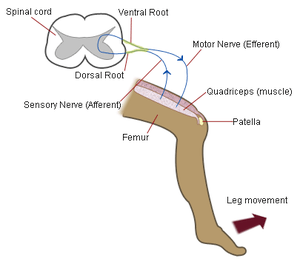
Patellar reflex.
Westphal's sign is the clinical correlate of the absence or decrease of patellar reflex or knee jerk. Patellar reflex or knee jerk is a kind of deep or stretch reflex where an application of a stimulus to the patellar tendon such as strike by a solid object or hammer caused the leg to extend due to such stimulus causes the quadriceps femoris muscle to contract.
It is named for Karl Friedrich Otto Westphal.[1][2]
Associated conditions
Westphal's sign has a clinical significance used in determining neurodisorders or diseases such as:
- receptor damage, peripheral nerve disease, involving the dorsal(sensory) columns of the spinal cord and cerebellar lesions
- lesions present within the motor cortex of the brain or the pyramidal tracts which it combined with muscular spasms
- complete interruption of sensory and/or motor impulse transmission in the femoral nerve
References
- ↑ synd/945 at Who Named It?
- ↑ C. F. O. Westphal. Über einige durch mechanische Einwirkung auf Sehnen und Muskeln hervorgebrachte Bewegungs-Erscheinungen. Archiv für Psychiatrie und Nervenkrankheiten, Berlin, 1875, 5: 803-834.
- The Principles of Physiology Jensen, David Ph.D.,Appleton-Century-Crofts, New York.1976
|
|---|
| | CNS |
|
|---|
| | PNS |
Reflexes of extremities/
corticospinal tract |
| Combination | |
|---|
| | Lower limb | |
|---|
| | Upper limb | |
|---|
|
|---|
| | Other torso/limbs |
| Upper limb | |
|---|
| | Lower limb | |
|---|
| | Torso | |
|---|
| | General | |
|---|
|
|---|
|
|---|
| | Mental/behavioral | |
|---|
|
|
anat (n/s/m/p/4/e/b/d/c/a/f/l/g)/phys/devp
|
noco (m/d/e/h/v/s)/cong/tumr, sysi/epon, injr
|
proc, drug (N1A/2AB/C/3/4/7A/B/C/D)
|
|
|
anat (h/r/t/c/b/l/s/a)/phys (r)/devp/prot/nttr/nttm/ntrp
|
noco/auto/cong/tumr, sysi/epon, injr
| |
|
| |
dsrd (o, p, m, p, a, d, s), sysi/epon, spvo
|
proc (eval/thrp), drug (N5A/5B/5C/6A/6B/6D)
|
|
|
|
